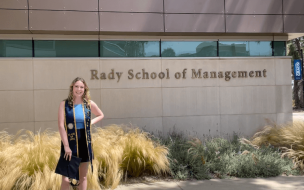The Pacific coast city is a hotbed of startup activity, with the US Chamber of Commerce and startup incubator 1776 naming it the fourth best city in the US for entrepreneurs last year.
At the University of California San Diego’s Rady School of Management alone, there are three startup accelerators, the Rady Venture fund, nearly 100 mentors, and as many as 28 entrepreneurship-related graduate courses on offer.
These resources are having tangible results, as figures for 2018 show that the number of companies started by MBA graduates over the last 5 years is 75, with 88% of MBA graduate ventures launched in the last 10 years still being in business.
But what is it that makes UC San Diego Rady School a good destination for entrepreneurship-focused MBAs?
Here’s six things you should look for in an entrepreneurship MBA:
1. A demonstrated history of entrepreneurship
According to Jay Bryant, director of graduate admissions and recruitment at the Rady School, entrepreneurial spirit is in the school’s DNA.
“Our school was opened about 15 years ago, so it’s one of the youngest business schools in the state, but the advantage of that was that the school was able to develop itself around what the world, and specifically California, needed from a business school at that time,” Jay explains.
“Things are invented in California—it’s a dynamic place to live because of that—and they wanted to build a school that was focused on innovation.”
2. A built-in incubation program
One way in which the school sets out to deliver this is through their Lab to Market program, which forms the capstone project of the MBA course.
The Lab to Market core sequence functions as a three-part startup incubator, with students progressing from a theoretical understanding of startups, through two practical workshops towards an actual business pitch.
“The first class is very theoretical, and at the end of it, the students write a paper or market analysis,” says Jay. “This tends to be where most schools will end—at least on required courses.
“The difference at Rady is that it’s required, but it’s more that the students choose to come to this school because it’s a project that everyone’s going to do.”
The outcome of the majority of these projects is an entrepreneurial venture, which is then pitched, Shark Tank-style, to a panel of business experts.
For those with entrepreneurial spirit, Jay says, this is a major selling point. “When I say that, you can see the students who are interested in that sort of project get really excited,” he laughs.
3. Commitment to innovation
The centrality of the capstone to the MBA curriculum has far-reaching consequences for the rest of the course.
“Because of the capstone, in every other class that’s taught at the Rady School of Management the faculty know that students have chosen to come to the school because they want to be an entrepreneurial part of the innovation economy—every class has that twist as it’s being taught,” Jay explains.
“We don’t just teach innovation marketing, we ask ‘How do we market for markets that don’t even exist yet?’ In financing, we look at risk analysis—what are you willing to take on as an entrepreneur? Or, if you’re going down the venture capital route, what should you be looking for?”
4. Time to develop your startup
With plentiful class time spent on learning how to materialize their business ideas, students get time to prepare for their postgraduate careers as entrepreneurs—particularly with the accelerator opportunities on offer.
“Accelerators are something that our students get excited to do,” says Jay. “People who go through the Lab to Market program get really excited about their project, because they get their ideas fleshed out so that they’re able to jump into other acceleration programs upon graduation.”
5. Alumni success
Indeed, this is what happened for Jimmy Wu, a 2017 Rady alum. Jimmy is the founder of Swapsy, a microfinance startup aiming to smooth the process of international currency exchange.
“I had an ambition to start my business before Rady, but I didn’t know the way,” Jimmy says. “I think it’s the two-year program at Rady that helped me to find the opportunity to start this business.”
In fact, Swapsy originated from a class project in technology and innovation at Rady, and was developed in StartR, one of the school’s accelerators. After graduation, the startup was then accepted into the EvoNexus incubator, a leading incubator in Southern California.
6. A broad MBA network
“I would give credit to the Rady accelerator, because one of the mentors from that program was on the selection committee at EvoNexus,” says Jimmy. “We didn’t need to apply online—we could directly give a presentation to the selection committee, and then we were admitted.”
For Jimmy, his MBA at the Rady School of Management at UC San Diego was an indispensable part of his success, and an experience he would recommend to other aspiring entrepreneurs.
“My current investor was introduced by a mentor from that accelerator,” he says, “They were classmates from business school.
“I would always recommend a potential MBA candidate to choose Rady if they want to start their own business,” Jimmy concludes. “The atmosphere is great and there’s a lot of hands-on help.”










